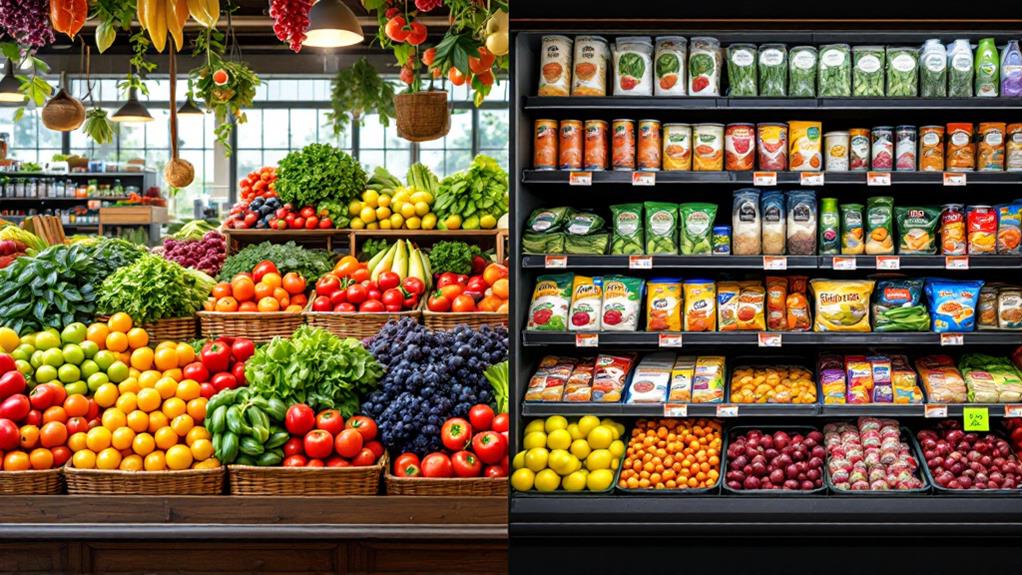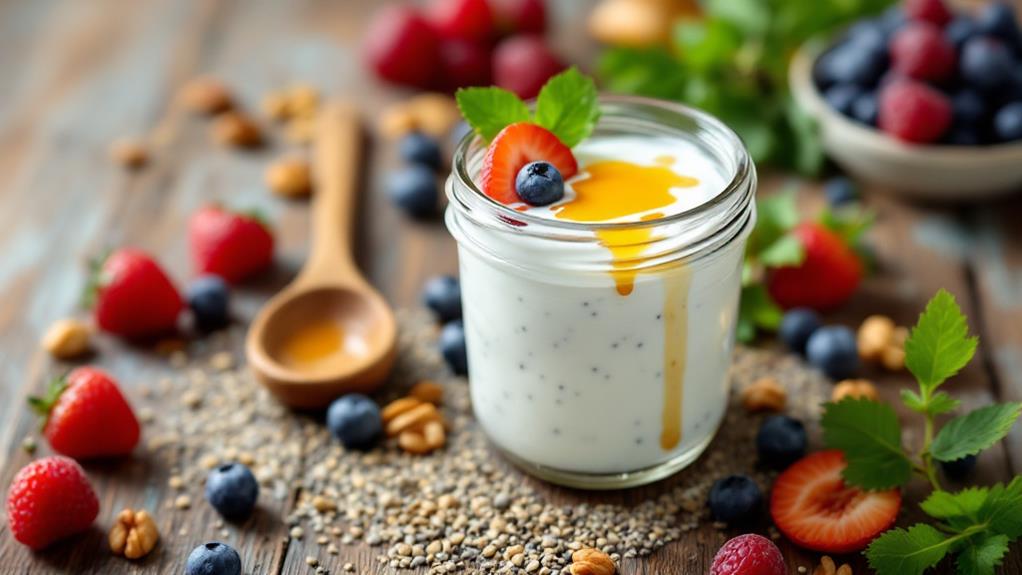Beat Diabetes by Cooking: Healthy Recipes to Manage Your Blood Sugar
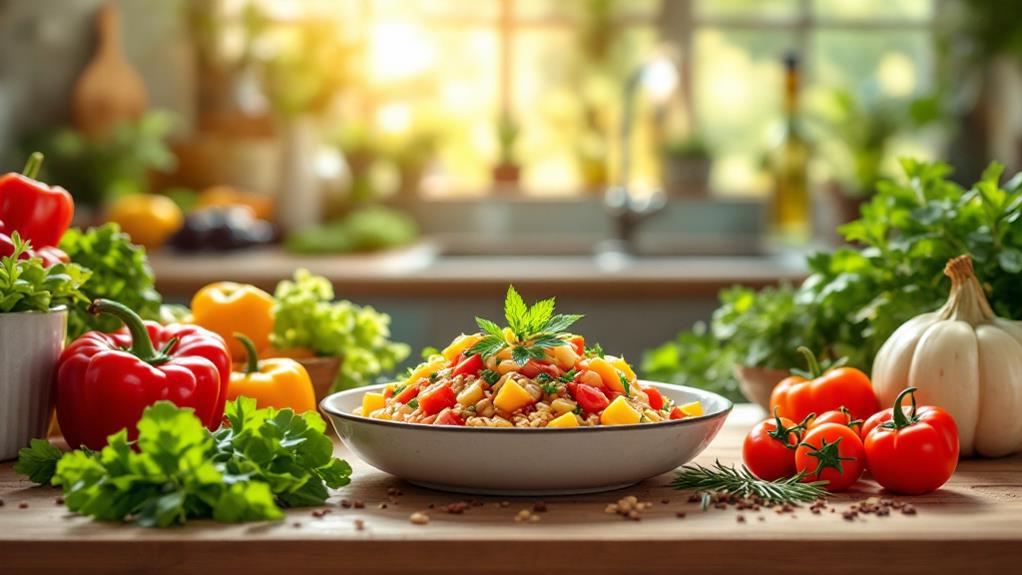
You can manage diabetes effectively by cooking meals that focus on balancing carbohydrates with fiber and healthy fats. Adopt low glycemic index foods like whole grains and legumes to slow glucose absorption. Cooking at home allows you to control ingredients, ensuring meals are made with fresh, whole foods that support stable blood sugar levels. Prepare high-fiber breakfasts such as quinoa oatmeal, nutritious lunches like kale and quinoa salad, and diabetes-friendly dinners with healthy fats from options like salmon-stuffed avocados. With meal prep strategies and flavorful, low-glycemic ingredients, you'll find plenty of ways to keep your meals both delicious and diabetes-friendly.
Understanding Diabetes and Diet
Understanding diabetes and diet is fundamental for effective management of the condition. You need to focus on balancing your carbohydrate intake with fiber and healthy fats to help regulate blood sugar levels. One key strategy is to include delicious recipes that incorporate lower glycemic index foods like whole grains and legumes. These ingredients slow down glucose absorption, helping to stabilize your blood sugar.
Incorporating fiber-rich foods such as fruits, vegetables, and whole grains is imperative. Fiber not only supports digestive health but also keeps you feeling full longer, which can prevent overeating. Pairing carbohydrates with protein or healthy fats further reduces the glycemic load of your meals, aiding in better blood sugar regulation. For example, adding a serving of nuts or avocado to your meal can make a significant difference.
Carbohydrate counting and portion control are essential components of your diet. Aim for 45-65% of your daily calories to come from carbohydrates, with a keen eye on portion sizes to avoid spikes in blood sugar. Through careful meal planning and preparation, you can enjoy nutritious meals that support your health and manage diabetes effectively.
Benefits of Cooking at Home
When you cook at home, you gain control over the ingredients you use, ensuring your meals are made with fresh, whole foods that are lower in sugar and unhealthy fats—crucial for managing blood sugar levels. This control allows you to tailor meals to fit your dietary needs, making it easier to stick to a balanced diet that maintains stable blood glucose levels. Plus, it's more economical than dining out, reducing food costs while focusing on nutritious, diabetes-friendly options.
Cooking at home also encourages healthier cooking methods like steaming or grilling. These techniques help retain nutrients and lower the glycemic index of your meals, which is a fundamental part of diabetes management. Engaging in home cooking promotes mindfulness about what you eat, helping you develop healthier eating habits and understand portion control better.
We've got a board to help you with meal planning, making it easier to incorporate these practices into your routine. By cooking at home, you not only improve your health but also foster a deeper connection with the food you consume, setting a strong foundation for a diabetes-friendly lifestyle.
High-Fiber Breakfast Ideas
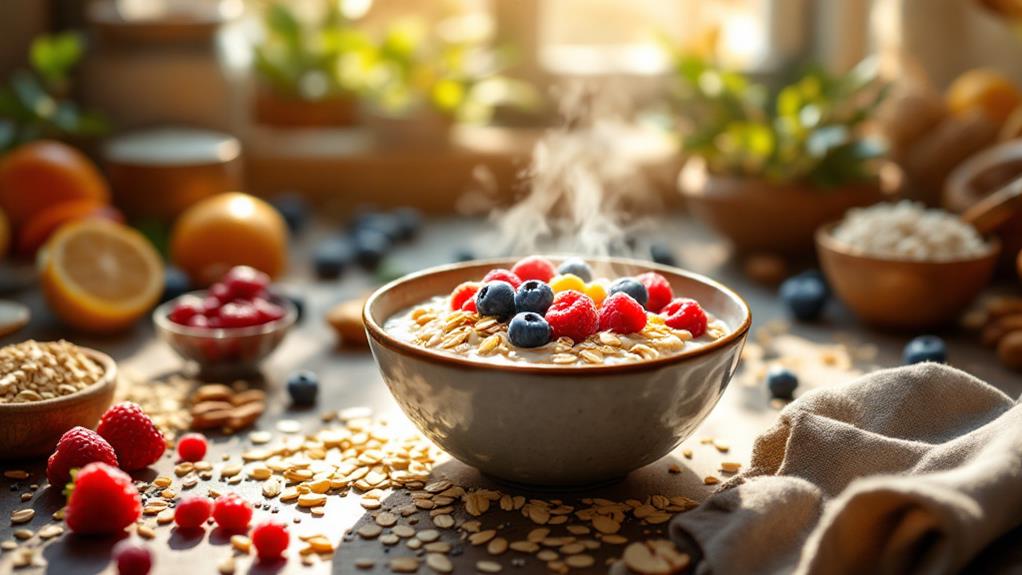
Starting your day with intention can set a positive tone for managing diabetes, and high-fiber breakfast ideas are a great place to begin. Quinoa oatmeal recipes offer a nutritious start, providing 6 grams of fiber per serving. This blend of quinoa and chia helps stave off hunger and maintains steady blood sugar levels throughout the morning. Adding raspberries to your oatmeal introduces natural sweetness and enhances fiber intake, making chocolate-raspberry oatmeal both delicious and advantageous.
If you're often on the go, baked banana-nut oatmeal cups might become your new favorite. They're moist, tasty, and packed with whole grains and fiber, supporting digestive health and stabilizing blood sugar. For a savory twist, consider using high-fiber ingredients like black beans in a winter kale and quinoa salad. Though traditionally a lunch dish, it can be a filling breakfast option, promoting a balanced diet for diabetes management.
Don't overlook the simplicity of smoothie prep. High-fiber fruits like mango and raspberries make an invigorating mango raspberry smoothie that delivers vital nutrients. By incorporating these high-fiber breakfast options, you're setting the stage for a healthier day and better diabetes management.
Nutritious Lunch Recipes
For a nourishing midday meal, nutritious lunch recipes are, without a doubt, essential in managing diabetes effectively. Start by considering a winter kale and quinoa salad with avocado. Quinoa benefits include being a complete protein and a great fiber source, which helps keep your blood sugar steady. This salad, packed with black beans, kale, and healthy fats from avocado, offers a delicious and filling option that's perfect for meal prep strategies.
If you're short on time, try a broccolini, chicken sausage, and orzo skillet. Ready in under 30 minutes, it's a lifesaver for those busy days. The fiber from broccolini and the lean protein from chicken sausage make it a balanced choice.
For a quick, high-protein option, a spicy slaw bowl with shrimp and edamame is perfect. It takes just 10 minutes to prepare and is loaded with veggies, making it a low-carb delight that supports general health.
Lastly, consider a three-bean chili, which is not only a fiber-rich, plant-based meal but also versatile. You can easily prepare it in advance, ensuring you have hearty, diabetes-friendly leftovers ready to go.
Diabetes-Friendly Dinner Options

Although managing diabetes might seem challenging, having a variety of diabetes-friendly dinner options can make a substantial difference. Start with dishes like the Broccolini, Chicken Sausage & Orzo Skillet or Peppery Barbecue-Glazed Shrimp. These meals incorporate protein sources such as chicken sausage and shrimp, which help stabilize blood sugar levels while offering important nutrients. Don't forget about portion control; it's significant for keeping your meals balanced and managing your blood sugar effectively.
Incorporating whole grains like orzo and quinoa is another excellent strategy. Whole grains improve fiber intake, crucial for blood sugar control. Try pairing Peppery Barbecue-Glazed Shrimp with Vegetables & Orzo or enjoy a Winter Kale & Quinoa Salad for a fiber-rich dinner. For a heart-healthy option, prepare Salmon-Stuffed Avocados. They provide healthy fats and omega-3 fatty acids, supporting heart health, which is important for individuals with diabetes.
Consider meal timing too. Quick recipes like Spicy Slaw Bowls with Shrimp & Edamame can be prepared in just 10 minutes, ideal for busy weeknights without compromising nutritional balance. Planning your meals ahead, like with Three-Bean Chili, guarantees you maintain consistent meal timing, a significant factor in diabetes management.
Low-Sugar Snack Suggestions
When you're managing diabetes, choosing the right snacks can make a big difference in maintaining stable blood sugar levels. Incorporating high-fiber snacks like raw vegetables, nuts, or hummus is an excellent snack pairing strategy. Fiber helps slow digestion, giving you steady blood sugar levels and increasing fullness. Opt for low-sugar fruits such as berries or green apples, which have a lower glycemic index and provide vital nutrients without causing spikes.
Mindful eating tips include selecting protein-rich snacks like Greek yogurt or cottage cheese. These options improve satiety and prevent blood sugar fluctuations due to their slower digestion rate. Whole grain options, such as air-popped popcorn or whole grain crackers, are more filling and have a lower glycemic impact compared to refined grains, making them ideal for snacking.
For a touch of creativity, try low-sugar desserts like chia seed puddings or nut butter on celery sticks. These snacks combine healthy fats, fiber, and protein for a balanced, low-sugar treat. By strategically choosing your snacks, you can enjoy satisfying and nutritious options that support your blood sugar management goals.
Easy Meal Prep Tips

Preparing meals in advance can be a game-changer for managing diabetes effectively. By planning your meals for the week, you can create a grocery list that focuses on meal prep fundamentals like low-glycemic foods, lean proteins, and high-fiber vegetables. This strategic grocery shopping guarantees you have everything you need to maintain stable blood sugar levels.
Incorporate time-saving techniques by batch cooking whole grains such as quinoa or brown rice. Store them in portioned containers to confirm you have healthy carbs ready to go. Quick-prep recipes are also a must-have in your meal prep arsenal. Dishes like Salmon-Stuffed Avocados or Three-Bean Chili can be whipped up in under 30 minutes, making it easier to adhere to your healthy eating plan without much fuss.
Investing in portion-controlled meal prep containers is fundamental. They help regulate serving sizes, preventing overeating, which is critical for managing blood sugar. Don't forget to add variety to your meal prep by incorporating different flavors and textures. This keeps your meals interesting and can help sustain motivation and adherence to your routine. With these tips, you'll find meal prep to be an indispensable tool in your diabetes management strategy.
Incorporating Healthy Fats
As you master meal prep for diabetes management, consider enriching your diet with healthy fats to further support your health goals. Incorporating healthy fat sources like avocados and nuts can greatly improve insulin sensitivity, aiding in better blood sugar control. Not only do these fats help manage your blood sugar, but they also boost satiety. By feeling fuller for longer, you'll find it easier to maintain portion control and avoid overeating, both vital for effective diabetes management.
Omega-3 advantages are another reason to include these fats in your diet. Foods rich in omega-3 fatty acids, such as salmon and flaxseeds, help reduce inflammation and may lower your risk of developing Type 2 diabetes. Moreover, by replacing saturated fats with unsaturated fats from olive oil and avocados, you can improve your lipid profiles, benefiting your heart health.
Healthy fats also offer fat absorption benefits by promoting the absorption of important fat-soluble vitamins like A, D, E, and K. This guarantees that your body gets the nutrients it needs for peak functioning. So, as you plan your meals, remember to include a variety of healthy fats for both taste and health benefits.
Using Whole Grains Wisely
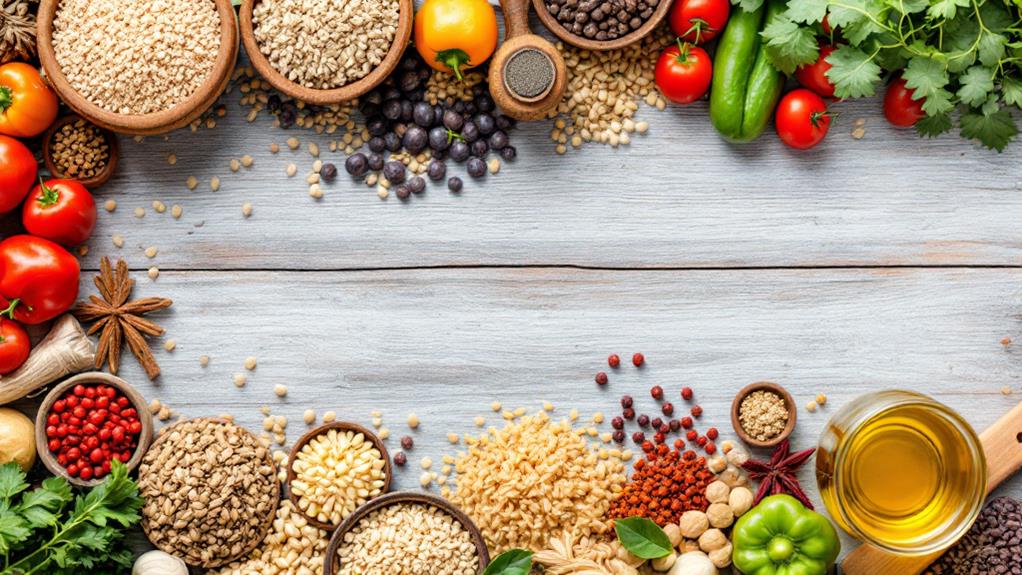
Whole grains are a powerful ally in diabetes management. They offer numerous benefits, thanks to their lower glycemic index compared to refined grains. This means they promote slower glucose absorption, helping you maintain stable blood sugar levels. Including whole grains like quinoa, brown rice, and whole wheat in your diet not only aids in managing blood sugar but also provides vital nutrients such as fiber, B vitamins, and minerals. These nutrients contribute to comprehensive health and can assist in weight management, which is vital for managing diabetes effectively.
To make the most of whole grains benefits, try different cooking techniques to keep your meals exciting. Cook grains in advance to save time on busy days. You can prepare a big batch of brown rice or quinoa and store it in the fridge to use in multiple meal variations. Think grain bowls, salads, or even stir-fries. Aim for at least half of your grain intake to come from whole grains, as this supports better glycemic control and reduces the risk of Type 2 diabetes. By wisely incorporating whole grains into your meals, you'll improve your diabetes management experience.
Flavorful Low-Glycemic Ingredients
Exploring nutritious options beyond whole grains can greatly improve your diabetes management experience. Start by incorporating legumes like lentils and chickpeas into your meals. They're rich in plant-based protein and fiber, which help you feel full longer and lower the general glycemic impact. For a flavorful twist, consider spice combinations such as cinnamon and turmeric. These spices not only elevate the taste but also potentially increase insulin sensitivity and lower blood sugar levels.
Non-starchy vegetables like leafy greens, broccoli, and peppers are excellent low-glycemic choices. They're packed with crucial vitamins and minerals, providing a nutritional punch without spiking your blood sugar. To make these veggies more exciting, use cooking techniques like roasting or grilling, which can improve their natural flavors.
Don't forget about healthy fats from sources like avocados, nuts, and olive oil. These slow down digestion, reducing the glycemic response when paired with carbs. If you're looking for ingredient substitutions, try swapping high-carb items with these healthy fats to balance your meals better. By integrating these flavorful low-glycemic ingredients into your diet, you can manage your blood sugar more effectively while enjoying delicious meals.

